 W
WThe shovelnose sea catfish, also called the short-nosed catfish or the marine catfish, is a species of sea catfish in the family Ariidae. It was described by Achille Valenciennes in 1840. It is a non-migratory species which inhabits tropical marine and brackish waters in the Indo-western Pacific region, including Indonesia, India, Pakistan, the Philippines and Thailand. It dwells at a depth range of 0 to 20 m. It reaches a maximum NG length of 39.5 cm (15.6 in), while commonly reaching a total length of 12 cm (4.7 in).
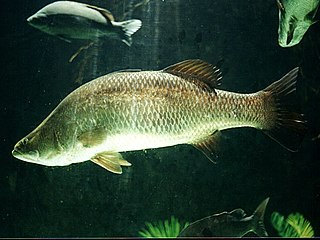 W
WThe barramundi or Asian sea bass, is a species of catadromous fish in the family Latidae of the order Perciformes. The species is widely distributed in the Indo-West Pacific region from South Asia to Papua New Guinea and Northern Australia.
 W
WThe ribboned pipefish, ribboned pipehorse or ribboned seadragon, is a species of pipefish found along the coast of northern Australia and New Guinea in habitats ranging from shallow and weedy to deeper and sandy bottoms down to depths of 16.5 m (54 ft). This species grows to a total length of 30 cm (12 in). Their colors can range from greenish yellow to brownish red. This species is the only known member of its genus.
 W
WLutjanus decussatus, commonly known as the checkered snapper, is a marine fish native to the western Pacific and Indian Oceans, from Sri Lanka to New Guinea.
 W
WThe giant mudskipper is a species of mudskipper native to the tropical shores of the eastern Indian Ocean and the western Pacific Ocean where it occurs in marine, brackish and fresh waters. It is most frequently found along muddy shores in estuaries as well as in the tidal zones of rivers. It lives in a burrow in the mud and emerges from the burrow at low tide on sunny days. It can move quickly across a muddy surface and is capable of breathing both in and out of water. The giant mudskipper can grow to a length of 27 centimetres (11 in) TL. This species is of minor importance to local commercial fisheries. The specific name honours the Dutch physician and naturalist Johann Albert Schlosser (1733-1769), who was a friend of Peter Simon Pallas and who received the type from the East Indies and sent it to Pallas.
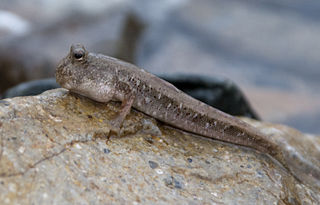 W
WThe New Guinea mudskipper is a species of mudskippers native to fresh and brackish waters along the coasts of Australia and Indonesia. This species occurs in estuaries and tidal creeks as well as mangrove forests and nipa palm stands This species can reach a length of 8 centimetres (3.1 in) SL.
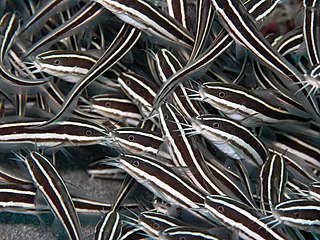 W
WPlotosus is a genus of eeltail catfishes native to the Indian Ocean, the western Pacific Ocean and New Guinea.
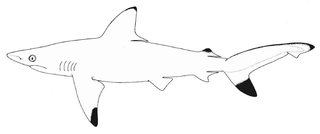 W
WThe Pondicherry shark is an extremely rare species of requiem shark, in the family Carcharhinidae. A small and stocky gray shark, it grows not much longer than 1 m (3.3 ft) and has a fairly long, pointed snout. This species can be identified by the shape of its upper teeth, which are strongly serrated near the base and smooth-edged near the tip, and by its first dorsal fin, which is large with a long free rear tip. Furthermore, this shark has prominent black tips on its pectoral fins, second dorsal fin, and caudal fin lower lobe.
 W
WThe brownbanded bamboo shark, Chiloscyllium punctatum, is a bamboo shark in the family Hemiscylliidae found in the Indo-West Pacific from Japan to northern Australia, between latitudes 34° N and 26° S, to depths of 85 metres (279 ft). Its length is up to 1.04 metres (41 in). While adults are overall brownish with faint suggestions of bands, the commonly seen juveniles are distinctly barred dark and pale.
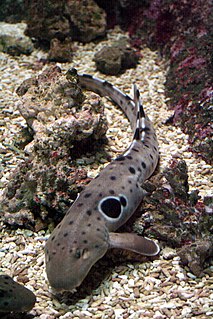 W
WThe epaulette shark is a species of longtailed carpet shark, family Hemiscylliidae, found in shallow, tropical waters off Australia and New Guinea. The common name of this shark comes from the very large, white-margined black spot behind each pectoral fin, which are reminiscent of military epaulettes. A small species usually under 1 m (3.3 ft) long, the epaulette shark has a slender body with a short head and broad, paddle-shaped paired fins. The caudal peduncle comprises over half the shark's length. Adults are light brown above, with scattered darker spots and indistinct saddles.
 W
WThe dwarf gulper shark is a dogfish of the family Centrophoridae found in the Indo-West Pacific oceans, from the Gulf of Aden, Japan, Taiwan, and northern Papua New Guinea. As a Squaliform, Centrophorus atromarginatus has high amounts of Squalene in its liver, and it is fished for this resource. It is a deep-water fish, whose habitat is in bathydemersal waters.
 W
WThe shovelnose sea catfish, also called the short-nosed catfish or the marine catfish, is a species of sea catfish in the family Ariidae. It was described by Achille Valenciennes in 1840. It is a non-migratory species which inhabits tropical marine and brackish waters in the Indo-western Pacific region, including Indonesia, India, Pakistan, the Philippines and Thailand. It dwells at a depth range of 0 to 20 m. It reaches a maximum NG length of 39.5 cm (15.6 in), while commonly reaching a total length of 12 cm (4.7 in).
 W
WThe pink-speckled shrimpgoby is a species of goby native to the western Pacific Ocean where it occurs on silty substrates in coastal reefs, lagoons, mangrove swamps and tide pools. It grows to a length of 12 centimetres (4.7 in) SL.
 W
WSynchiropus splendidus, the mandarinfish or mandarin dragonet, is a small, brightly colored member of the dragonet family, which is popular in the saltwater aquarium trade. The mandarinfish is native to the Pacific, ranging approximately from the Ryukyu Islands south to Australia. It can usually be found in some of the warmer waters.
 W
WThe mangrove whipray or whitetail stingray, is a species of stingray in the family Dasyatidae. It is widely distributed in the Indo-Pacific region from the Red Sea to northern Australia and Micronesia. A benthic inhabitant of shallow inshore waters, juvenile mangrove whiprays favor mangrove and estuarine habitats, while adults favor sandy to rocky areas in lagoons and coral reefs. This species can be identified by its thick, oval pectoral fin disc that is dark gray above with numerous white flecks, and by its relatively short, whip-like tail that is white past the stinging spine. It grows up to 1.4 m (4.6 ft) across.